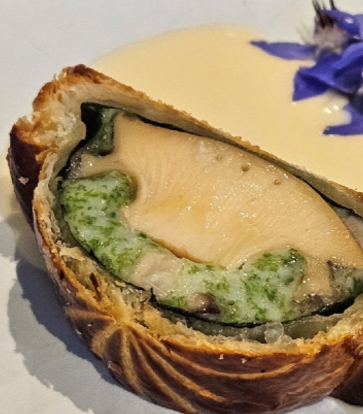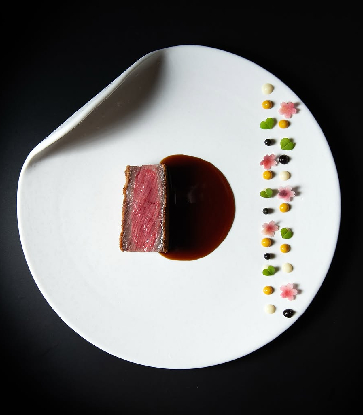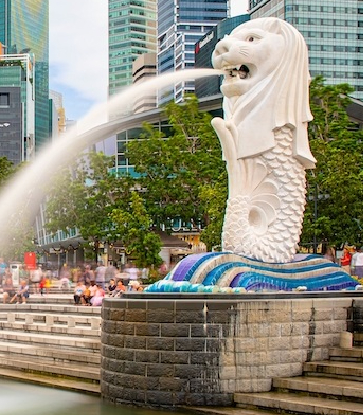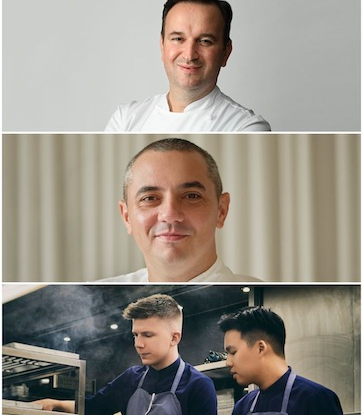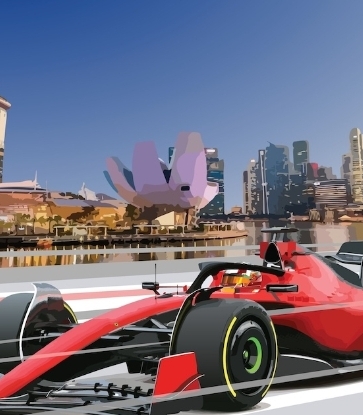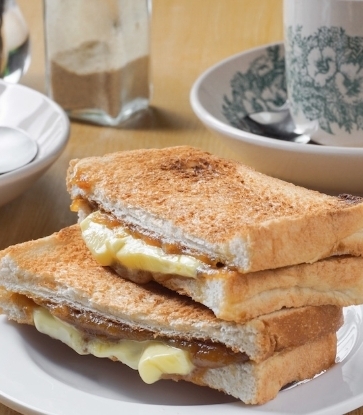Before the advent of canning and plastic packaging, local food manufacturer Amoy Canning used to pack candied ginger in collectible jars. It is best known for its soya sauce, canned vegetables and curries and food pre-mixes that are sold in supermarkets under the Amocan branding.
George Huang, the third-generation managing director of the 111-year-old family-run company, says that the ceramic vases, which were also exported to the United Kingdom, served dual purposes. Speaking to the MICHELIN Guide Digital after the launch of the exhibition, he says: “The British loved candied ginger as snacks and some of them bought these as gifts, so we exported a good volume of goods to the United Kingdom. It was a way for people to remember us by keeping these vases as mementos.”

Candied Ginger In Elegant Jars
While the vases seem exquisite in today’s context, Huang adds that these vases, which were typical of the era, were produced in Guangdong, where each village has its unique designs produced in its kilns. Secured with a string that is tied over these ceramic jars, they were held securely in steamboats that transported them to ports around the world.
Later, the production of ceramic vases was halted during the Cultural Revolution in China. Due to a lack of resources, the vases were replaced with tin cases, which were more compact and durable. In 1951, Amoy Canning, which was founded in Xiamen, opened a factory in Singapore and started adding new local products such as canned curry chicken and vegetarian Chinese food such as mock vegetables and chicken. In the past decade, it has branched into cooking kits for local favourites such as bak kut teh and chicken rice.
These fascinating stories have been unearthed at a new exhibition at the National Museum of Singapore, called Packaging Matters: Singapore's Food Packaging Story From The Early 20th Century, which runs till 15 September. The exhibition features more than 150 food packaging artefacts which have been collected from the 1950s to 1960s. They range from beverage bottles, advertisement banners, paper bags, biscuit tins, cups and saucers, trays and even a clam-shelled McDonald's Big Mac polystyrene container that was collected in 1975.
READ ALSO: Six Singapore Food Brands That Have Taken Flight Overseas
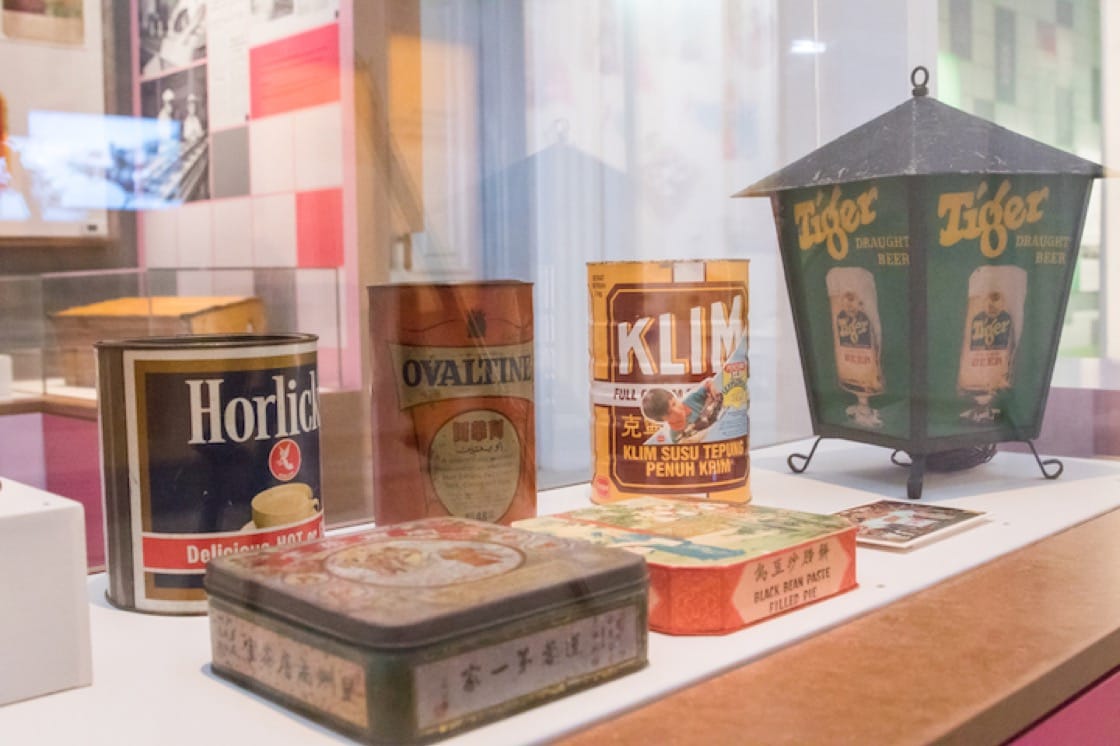
Vidya Murthy, the curator of the museum’s first exhibition dedicated to food packaging, points out that many facets of Singapore heritage can be gleaned from food packaging. “Food packaging can be linked to industrialisation, as Singapore had a vibrant food manufacturing scene with many family-run food companies. It can also give us a clue into people’s lifestyle and popular culture.”

Unearthing Stories From Food Packaging
What fascinated her most during the year-long research were the designs of more than 30 drink bottles from brands such as Sinalco, Kickapoo and Green Spot. She says: “Even after I whittled the number of bottles down, it was amazing to see how much effort the companies had put in to make their bottles distinctive when they were placed next to each other in shops. There are many quiet multilayered stories in brand designs that are waiting to be told.”
From Pineapple Canning To Family-Run Food Production Businesses
The exhibition also chronicles the evolution of the Singapore food packaging industry, from the rise of the canned pineapple industry in the 19th century (these cans were exported to as far as the UK).
Back then, pineapples were an important catch crop for rubber plantations as the tropical fruit could be harvested within 18 months. In comparison, rubber trees take at least six years to mature before their sap can be harvested. The pineapples were diced and canned to prolong their shelf lives and broaden their distribution. However, pineapple farming diminished during World War Two and the pineapple canning industry went into decline subsequently.
In the 1950s, the rise of industrialisation saw the start of family-run small-scale food businesses that produced and processed uncooked food products such as soy bean milk, vinegar, beancurd skin, noodles and ground coffee powder. These household brands include Prima Flour, which was one of Asia’s first flour mills that are started in 1961 and biscuit maker Khong Guan, which is known for its cream crackers and lemon puff biscuits. By 1959, Khong Guan’s Singapore factories churned out 10,000 tins of biscuits daily. About three-quarters of its products are sold in Singapore and Malaya. By 1970, production of its tinned biscuits hit 15 tonnes per day. From family-sized biscuit tins, Khong Guan moved on to pack its biscuits in plastic packs.
Drinks giant Yeo’s, or Yeo Hiap Seng, is best known for its wide range of packet drinks that run the gamut from chrysanthemum tea to iced lemon tea. However, not many know that it started out producing soya sauce in Fujian province in China. However, the company was one of the first in the world to package beverages in Tetra Pak carriers. Its slim rectangular package were easier to store, stack and distribute, which helped to lower transportation costs.

Another segment of the exhibition is the emergence of supermarkets in Singapore. The Cold Storage chain, which started a retail shop in Orchard Road in 1905, was a symbol of progression and affluence during colonial times. Other note-worthy supermarkets include Tay Buan Guan that started in Joo Chiat in 1948 and Fitzpatrick’s, which opened in 1958.
Supermarkets also shaped the way that food was produced. Cans and boxes became more prevalent as it was easier to stack and display them on shelves along aisles. The entry of Cold Storage supermarkets also altered food consumption habits as products such as frozen food, dairy products started appearing in diets. For example, Cold Storage started butter manufacturing at the Magnolia Dairies complex in Bukit Timah in 1969.
The Age Of Disposable Food Packaging
The fast food culture grew in the 1970s and 1980s, which saw the rise of light, compact and easily disposable food packaging made with industrial materials such as styrofoam. To highlight this aspect, the exhibition showcases a clam-shelled McDonald’s Big Mac polystyrene container that was collected in 1975. The growth of the range of products in supermarkets and takeaway food culture also contributed to the rise of disposable food packaging. Styrofoam was the material of choice as it serves as an efficient thermal insulator, which maintains the temperature of the food.

One local food company that has seen the tide of change in food packaging is Amocan, which produced canned food, soya sauce and candied ginger. It also used to distribute Green Spot soft drinks here.
Huang says with a chuckle: “In the 1930s to 1950s, we packed soya sauce in clay jars and covered it with a piece of paper that was tied with a string.” Later Amocan branched into tin-canning as 40% of ceramic jars that stored preserved fruit and vegetables were broken when they were exported to the Philippines on rocky ship journeys in the South China Sea.
During the Second World War, Amocan supplied canned baked beans with pork to the Red Cross, which distributed them to British prisoners of war (POWs). In a twist of fate, one of the POW quartermaster was so grateful to Amocan for the food that he helped the company to procure soya beans and tin plates to jump-start the canning line after the war.

Environmentally-Friendly And Smaller Packaging
These days, Amocan makes more than 120 products, ranging from food pastes, canned food to sauces. In the noughties, it introduced food pastes in smaller packets and bottles to suit the time-starved lifestyles, in which people want fuss-free cooking and do not cook often, and smaller families. These seasonings include sweet and sour, black pepper and pineapple rice pastes. The information on the packaging also has to move with the times. The packaging of its food pastes and premixes include recipes and cooking tips, on top of listing the nutritional information and ingredients.
Huang also notes that the food packaging also consumes less materials such as paper and cardboard in a bid to become more environmentally friendly. Last year, it introduced the bak kut teh spice packs that are vacuumed-packed in slimmer and intuitively designed aluminium pouches. Previously, they were packed in cardboard. Amocan, which exports products to 28 countries, also has products such as soya sauce are also packed in travel-friendly sizes.
In a similar vein, the Packaging Matters exhibition also shines a spotlight on eco-friendly practices in light of the increase of non-biodegradable packaging waste. According to the Ministry of Environment and Water Resources, packaging makes up one-third of household waste in Singapore and more than half of this consists of packaging for food and drinks. In recent years, more eateries are using eco-friendly cutlery made from sustainable sources. These materials include birch wood, sugarcane pulp, wheat and paper.
The exhibition invites visitors to explore eco-friendly practices and sustainable alternatives through art pieces that have been upcycled by packaging materials. Kids can also identify various types of recyclable packaging materials through hands-on activities in the sustainability section.
On what Murthy hopes that visitors can take home from visiting the exhibition, she says: “I hope that this exhibition gives them a fresh perspective of our history through a topic that is close to the hearts of many — food — and explore our food heritage through our vast national collection and the interconnected stories of those in the food packaging industry.”
”
Packaging Matters: Singapore's Food Packaging Story From The Early 20th Century exhibition is on till 15 September at the National Museum of Singapore.








